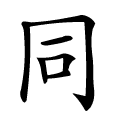同
- same, together;
- collective;
Etymology
In oracle bone script, depicted as 凡 (all, every) over 口 (mouth) — originally showing many voices (凡) gathered into one mouth (口), symbolizing unison or sameness.
Later stabilized as 同, a compound graph meaning “to be alike, to share, to be together.”
Semantic range:
- same, identical (같다);
- together, with (함께, 같이);
- group, collective, class (무리);
- by extension, agreement or concord.
Usage in Korean
同一 (동일) — same, identical
同心 (동심) — of one heart, united
同志 (동지) — comrade, like-minded person
同行 (동행) — to go together, companion
同感 (동감) — same feeling, sympathy
共同 (공동) — joint, mutual, shared
同族 (동족) — same clan or race
Words that derived from 同
- 공동(共同)–collaboration
- 공동 사회(共同社會)–community; communal society
- 동(同)–the
- 동갑(同甲)–same age
- 동등(同等)–equality
- 동문(同門)–alumni
- 동서(同壻)–sister-in-law; brother-in-law
- 동성애(同性愛)–homosexuality
- 동시(同時)–simultaneousness; concurrence; coexistence
- 동시성 시대(同時性 時代)–parallel providential periods
- 동일(同一)–sameness; identicalness
- 동일하다(同一하다)–being the same; identical
- 동지(同志)–comrade
- 동형(同形)–same shape
Additional notes
In Confucian texts, 同 is often contrasted with 和 (harmony):
“君子和而不同,小人同而不和” — “The noble person seeks harmony but not sameness, the petty person seeks sameness but not harmony.”
Here, 同 warns against mere conformity, while 和 represents higher, balanced unity.
Thus, 同 plays a key role in classical discussions of individuality vs. conformity, and harmony vs. uniformity.
Alternative forms
仝 (ancient form, also basis for Japanese 々);
衕 (originally “alley,” simplified as 同).
- 月一口 (BMR)
- ⿵ 冂 𠮛
